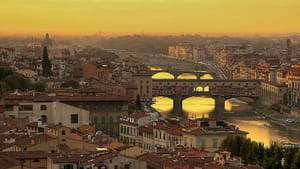Stay in the Loop
BSR publishes on a weekly schedule, with an email newsletter every Wednesday and Thursday morning. There’s no paywall, and subscribing is always free.
Sorrows of a Florentine traveler
A solo visit to Florence

Before I went to Florence I wasn’t aware that it had become one of the most popular European getaways for Americans, especially for couples and groups. I, however, was alone. I’d been traveling with a married couple from Philadelphia, first to Paris, but then by myself to Florence because the couple had gone their separate ways, the wife back to the States and the husband to Rome to visit his mistress.
But once in Florence, I was enchanted: I saw many of the same medieval streets that Michelangelo, Leonardo, and Shelley once traveled. The narrow streets, sheltered from the noonday sun by the close proximity of buildings, have sidewalks barely a yard wide. Strolling along these intimate byways can be a hazardous endeavor — at any moment a motor scooter can zip up behind you. Because of this, it’s best to keep from daydreaming when you marvel at the 15th-century doors, the historic cobblestones beneath your feet, the religious mosaics or icons encased below the second-story windows, or that worn plaque above a door describing a famous 16th-century occupant.
Where Florence’s small streets splinter into myriad pathways, you may come out onto Piazza della Signoria,  the city’s main square, and find large numbers of locals and tourists mixing together. There are so many merchants from West Africa, Algiers, and Morocco hawking their wares that sometimes you forget you are in Italy. In addition to the leather goods Florence is known for, the street markets also offer tapestries and jeweled wristwatches with humble Timex prices. This is a bargain hunter’s paradise.
the city’s main square, and find large numbers of locals and tourists mixing together. There are so many merchants from West Africa, Algiers, and Morocco hawking their wares that sometimes you forget you are in Italy. In addition to the leather goods Florence is known for, the street markets also offer tapestries and jeweled wristwatches with humble Timex prices. This is a bargain hunter’s paradise.
Italian hotels, it turns out, don’t have irons, so I wore a wrinkled shirt to the city’s main cathedral, Santa Maria del Fiore, the Duomo, built in the 13th century but constructed on the site of a 7th-century church, Santa Reparata. The cathedral’s massive pink, white, and green marble exterior looms over Florence like an occupying army. Considered one of the finest examples of Renaissance architecture, it has a dome, designed by Brunelleschi, that reminded me of multicolored taffy.
The cathedral is a cavernous space with a surprisingly stark interior, reminiscent of the soaring but “empty” architectural styles of Catholic churches built after Vatican II. "A super Spartan structure,” I thought, “Take away the few mosaics and the simple altar, and you have a mosque.” The long line of tourists that assembled on a downstairs staircase suggested a basement catacomb crypt filled with skeletal saints, but that was not the case at all: The draw was a small book and souvenir shop, and a bad one at that.
A small city by any standard, Florence’s boundaries can be walked in 45 minutes, about the time it takes to walk from University City to Penn’s Landing. That walk would include a stroll along the Arno River, where you’ll get a good view of the rowers and the Tuscan hills, and your only challenge will be navigating the throngs of tourists — camera-laden Japanese, ice-cream-cone-licking Americans, and student contingents the size of small villages — as you cross the Ponte Vecchio to the city’s other side.
 The Disneyland-style tourist convergence permeates the whole of Florence, but on the Ponte Vecchio the only things missing are costumed Mickey Mouse and Donald Duck impersonators. The elbow-clashing crowds forced me to beat a hasty retreat into a number of museums where I saw reliquaries, each one more elaborate than the next. In a way I began to understand why my friend, who had been to Florence many times, opted to go straight to Rome to visit his mistress.
The Disneyland-style tourist convergence permeates the whole of Florence, but on the Ponte Vecchio the only things missing are costumed Mickey Mouse and Donald Duck impersonators. The elbow-clashing crowds forced me to beat a hasty retreat into a number of museums where I saw reliquaries, each one more elaborate than the next. In a way I began to understand why my friend, who had been to Florence many times, opted to go straight to Rome to visit his mistress.
While walking through the city, I was often almost sideswiped by buses that seemed to scrape the edges of the sidewalks. Other times, I’d do a fast U-turn when I’d spot yet another tourist group with its flag-toting guide. But escaping madcap buses and tourists is easy when you have the museums, cafes, and shops that Florence offers in abundance.
 The Galleria degli Uffizi is the city’s most complete Italian painting gallery. It has paintings by Giotto, Paolo Uccello, Botticelli, and Michelangelo. The museum is much bigger than it looks; one can spend an entire afternoon not only contemplating the works of art, but also enjoying the spectacular views from the windows. Much of the Uffizi collection came from members of the Medici family.
The Galleria degli Uffizi is the city’s most complete Italian painting gallery. It has paintings by Giotto, Paolo Uccello, Botticelli, and Michelangelo. The museum is much bigger than it looks; one can spend an entire afternoon not only contemplating the works of art, but also enjoying the spectacular views from the windows. Much of the Uffizi collection came from members of the Medici family.
I also visited small museums like the Palazzo Medici Riccardi, which offers a selection of religious panel paintings from the early Renaissance. Here, I spent a serene hour before rejoining the parade of tourists outside. My friend had warned me that many Italian cultural institutions and museums open and close sporadically throughout the day. “This is no normal 9-to-5 world,” he said. Often I would go to a museum only to find it closed even though I’d been assured by the hotel desk clerk that it would be open.
A serene, almost mystical quiet descends on the city about midday as the light patterns mellow into an orangey hue. This is when you’re likely to find locals basking like lizards in the midday sun. It’s a transcendental time that makes you happy that you are in Italy, even if traveling alone.
Nightlife in Florence can be a raucous affair, ranging from the sedate cafes to rowdy bars and clubs. Boisterous teens and young people jam the tiny streets carrying their drinks from bar to bar, often blocking pedestrian traffic. Hooliganism is rare, however; the crowds part like the Red Sea when you walk by and say, “Excuse me.”
Good restaurants are easy to find in this city of good food, bread, and charming Chianti. I found the best medium-priced places near my hotel and the vicinity of the train station. For a mere 16 euros, one can enjoy authentic Italian cuisine that many Italian-American restaurants can only dream to duplicate: sumptuous pasta, breads, and delectable red table wines that will make you want to prolong your dinner for hours, even if dining alone, as I did night after night. Of course, I had always hoped to meet someone despite the fact that everyone in the city seemed coupled or connected to a group. This fact recalled for me D. H. Lawrence’s line in Women in Love that there’s something disturbing about the whole world being divided up into couples. Walking the city’s narrow streets late at night, I thought of this line a lot.
Sign up for our newsletter
All of the week's new articles, all in one place. Sign up for the free weekly BSR newsletters, and don't miss a conversation.
 Thom Nickels
Thom Nickels